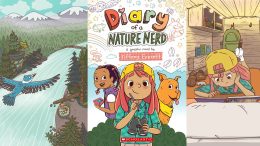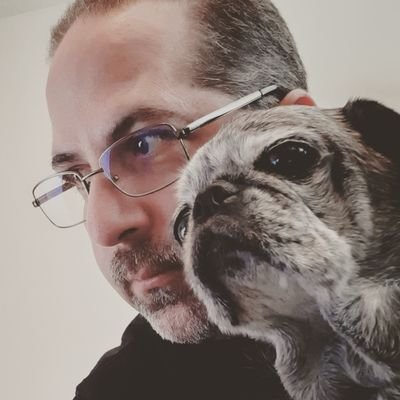What’s the top animal species you can’t stop dreaming about seeing in the wild?
For Brooke — one of the main characters of Tiffany Everett’s delightful new graphic novel, Diary of a Nature Nerd — the answer is a moose. She’s fascinated by them, but her attempts to observe one and document the sighting in her nature journal have been thwarted at every turn.
Brooke’s emotional quest sits at the core of the book, which sees her newly blended family — including her less-enthusiastic-about-nature best friend/stepsister — travel to Washington state’s North Cascades National Park as a combination honeymoon-slash-scientific expedition.
It’s the first full-length book both illustrated and written by Everett, who previously illustrated several science- and nature-based books for kids and who also maintains a busy YouTube channel with her partner about their full-time travel.
The Revelator sat down with Everett to talk about her new book, the excitement and value of nature journaling, and life on the road.
(This conversation has been lightly edited for brevity and style.)
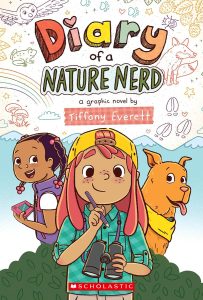 So where are you calling from these days? Are you still 100% mobile or…?
So where are you calling from these days? Are you still 100% mobile or…?
No, I’m in Auburn, Alabama, but we’re getting ready to hit the road again.
Aha. Will you be using the same modified bus I saw in your videos?
No, we’re done with the bus. We’ve got a van and we’ve done a truck camper with a pop-up tent on the back. And we did a scamp, which is one of those little fiber fiberglass egg-shaped tiny campers. And we just built out another van to travel in.
Wow. Did you do this whole book while traveling around mobile?
No, funny enough. I started the book while I was mobile, and then when I got the deal, I was kind of overwhelmed with the thought of how much work was in front of me. So we got a house here in my hometown for little while. I did basically the whole book here. But now I’m itching to get back on the road.
Great. So tell me, why did you write this book, and what do you hope readers are going to get from it?
Well, there are a lot of reasons I wanted to write a book like this one. One of the main reasons is I get really excited when I see an animal in the wild. And I see that same excitement for kids and adults alike when I’m hiking and we pass somebody and they’re like, “we just saw some deer up there, be quiet and you won’t scare them away.” They just light up.
And I think as a kid, one of the most important questions is “What’s your favorite animal?” So many kids pick some faraway species, which is wonderful. But I want to remind kids that there’s some amazing animals right here in the U.S.
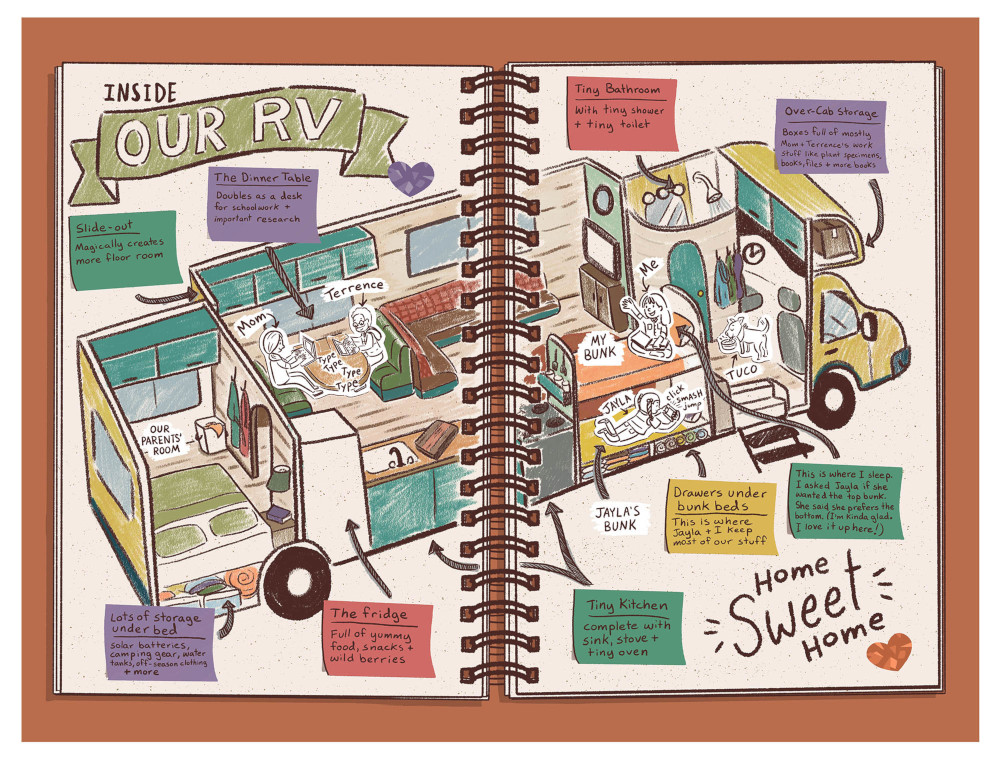
And I wanted to shine a light on nomadic life, because my partner and I have lived out of a school bus, in a van, and a camper. When we tell people that, we’re often met with a lot of confusion, especially in the east and from family and stuff. I think it’s a misunderstood way of life, but it’s a lifestyle a lot of people choose. I enjoy my time living in the campers and it has brought me closer to nature. That’s just something I want to have front and center in this book.
Cool. And this is your first book-length comics work. You described it as “an emotional experience” on your website, but at the same time it’s a progression of your other illustrative work, which is science- and nature-based. Tell me about that journey and how all this work fits together.
I always wanted to be an illustrator. I kind of thought writing was out of reach for me, because I’m a visual person. But what’s cool about graphic novels is it marries the two. It’s as much about the illustrations as it is about the text.
I love illustrating nature and science. I like to be as specific as I can. I put a lot of research into it.
When I finally got to write my own story, I naturally wanted to build this whole world around nature and science, because I knew I would learn a lot while I did it.
What was your biggest challenge doing the book?
It was nothing but challenges [laughs]. I had never written before, I had never worked on a graphic novel before, and I’d never worked on a project of this size before. At 128 pages, that’s around 600 illustrations — it’s a lot of work.
I put a lot of research into it. I tried to be careful, but I still missed some things. And I’m lucky that I had some expert reviewers look at the book and find some things.
For example, there was a panel where I illustrated a river otter floating on its back. And the expert reviewer was like, only sea otters float on their backs. And that was a cool fact that I didn’t know, so I fixed it.
There was a lot of help behind the scenes, but it was an amazing journey.
You could have set it anywhere. You could have set it in your home state of Alabama. But you chose North Cascades. What attracted you to that setting?
One of the main reasons is it was one of the most recent parks I had visited when I started writing the story.
When I first got to North Cascades, I was in a very raw emotional state because we had just driven days through wildfire smoke. And when we got there, we finally got a break from it. We ascended the mountain and suddenly the skies were clear and it was lush and green. We got to Diablo Lake and saw that iconic view. It was like a sigh of relief.
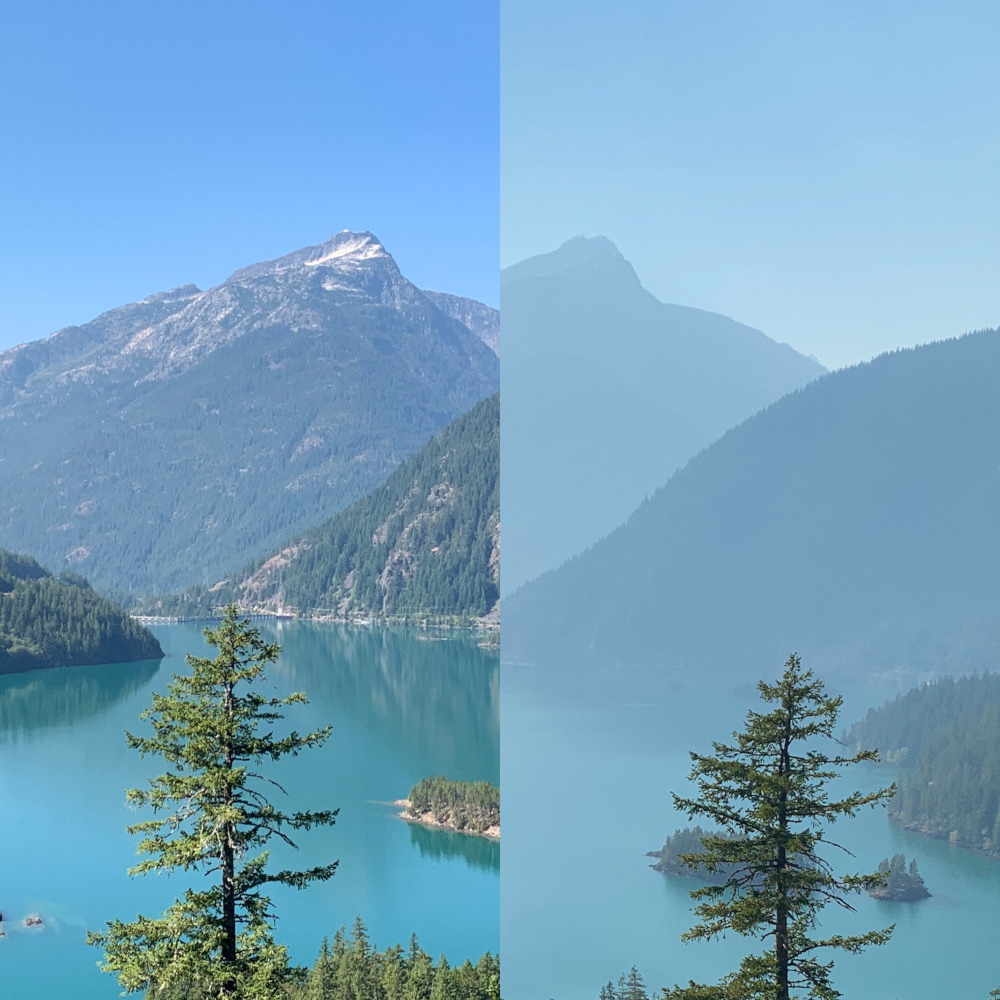
We camped there for two weeks. And for that first week, we didn’t have any wildfire smoke. It was a week of heaven after a pretty stressful experience.
During that week the blackberries were everywhere. I saw my first banana slug, which was very exciting. It was the first time I had seen trees of that size — just mind-blowing.
It’s definitely one of my favorite national parks, and I’ve been to 26 of them.
On that note, how do you feel about all the threats to national parks right now?
I get really frustrated reading about shortsighted plans that don’t adequately protect the wild spaces we still have. I’m deeply disheartened by the administration’s decisions to cut funding for America’s best idea, national parks, and conservation as a whole. My hope is that my book inspires some kids to put nature forward and that our natural resources are worth vastly more than dollars and cents.
Tell me about the nature journal portion of the book. It both conveys information and Brooke’s character. It’s a completely different art style, while also complementary to your regular art style. How did you develop that? What were your goals with these areas of the book?
I knew I wanted the nature journal to be the heart of the book. I think it was fun to draw things in Brooke’s style. It kind of broke it up for me artistically.
The nature journal throughout the book is a place for her to record her animal observations, which is a huge part of her personality, but she also uses it like a true diary. She hides little folded pieces of paper in the notebook where she can write her personal thoughts.
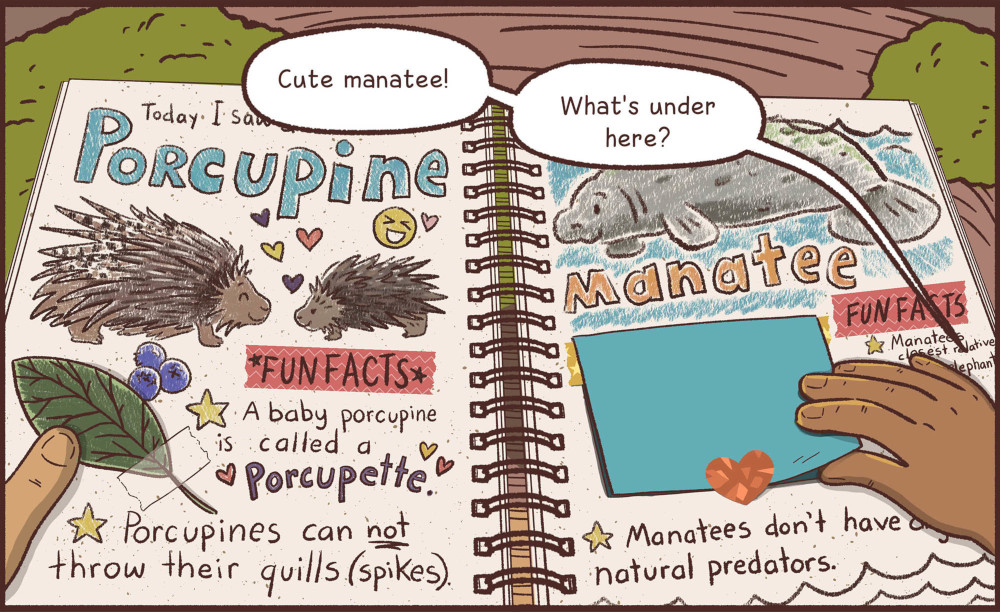
Her drawings kind of change — she starts by putting a lot of effort into her drawings and adding cute, fun facts and stuff. And then when she’s frustrated, her drawings reflect her feelings, and they get messy and sloppy, and she doesn’t care about it anymore. That’s so unlike this character, because this is a kid who thinks anytime she gets to observe an animal in the wild, no matter if it’s a grizzly bear or a squirrel, that’s exciting. But she gets so blinded by her obsession that she doesn’t care anymore and you see that in her drawings.
That’s one of the questions I wanted to ask. She’s so obsessed with seeing her “number one mammal” and she gets upset when she doesn’t see it and when her family members do. And I can understand that feeling. I’ve had species I wanted to see, and other people say, “I just saw one…”
“And you just missed it.”
Yeah! So I found it interesting that that was what created the drama of the book and allowed you to reveal so much character. Why did you choose that as the plot element?
Well, I think because, like you, I can relate to that feeling. You know, Brooke has spent almost her entire life camping. And a moose is her number one favorite animal. Somehow it’s the one she’s never seen. And we can imagine that there’s been a lot of times where she almost saw one, where she’s on the trail and somebody was like, “we just saw a moose.” And then the disappointment she probably feels when it’s gone, when she gets to that spot.
So then her best friend-turned-sister, Jayla, sees the moose in her very first week of camping — her reaction to that is big. At first Brooke is kind of cold to Jayla. She probably doesn’t even know why, because that’s how jealousy can feel sometimes. It’s kind of a complicated emotion, and the story is all about Brooke navigating her own feelings and learning to be happy for somebody else.
Obviously not every family can take this type of immersive experience. Are there ways kids can translate the lessons of the book to their backyard or their urban environment or their neighborhoods?
Yeah, absolutely. You don’t have to go far to have an experience in nature. You can just go to your backyard or a local park.
If you bring a notebook, and any kind of art supplies — any notebook works, any art supplies work — and can you just sit and pay attention. Squirrels and birds and chipmunks or whatever you have near you can provide endless entertainment. You just need to slow down and pay attention to it.
Some of the advice I’ve gotten from other artists is that the very process of slowing down, like you just said, and capturing an animal or plant in linework helps you see it in new light. It brings new observations that you might not have noticed otherwise.
Absolutely. One of my favorite resources for nature journaling — and I think this is a good resource for kids and adults — is John Muir Laws and the Wild Wonder Foundation’s amazing YouTube videos for cool things like how to nature journal.
I think it’s important for everybody to remember that nature journal journaling is not about making pretty pictures. If you enjoy that, that’s great, but that’s not what it’s about. It’s about making you slow down and notice things. These videos point out all the kinds of things you can make notes about, and it makes you just think about what’s going on. Like, what time of day did I see this, what season is it, what kind of tree was it in — stuff like that.
And just as a side note, it’s amazing how some of those journals from maybe a century ago contained vital science that reveals how animal migration has changed, how the climate has changed. People are tapping into this stuff either from their own lives or from generations past and learning new things.
One-hundred percent. And that’s something else that I hope readers get from this book: that everybody can be a scientist. It doesn’t matter what age you are. You don’t have to be a great artist. Making these observations — it’s fun for you, and it could actually be something that somebody learns from one day.
Speaking of observations, were any of the wildlife scenes you drew in the book things you’ve seen?
Oh yeah. Brooke’s top 10 most wanted mammals list is essentially my own wish list.
I’ve seen half of the ones on her list. I’ve seen a moose, but I haven’t seen a moose swimming, which I think would be really cool.
Every time I get to see any animal in the wild, it’s an honor. Even deer and squirrels and stuff — like when you’re hiking and you get to share the space with these deer and they look at you and stop, and then they decide that you’re not a threat and they keep eating. It’s so cool just to slow down and watch them for a little bit.
The book’s been out for a few weeks. You’ve done some author events — how are kids responding?
Well, I’ve been blown away from responses. It’s humbling. I did my first author event last weekend, and it went really well. The kids were so excited and they asked great questions.
We did a draw-along, where I showed them how I draw from references and how you can break down any image into shapes and draw anything. We drew a fox together and all the kids’ fox drawings looked great — they were all so unique and they had their own style, but they were all definitely foxes.
View this post on Instagram
And I’ve had parents reach out and say that their kids devoured the book in one day and we’re looking for book two.
So what does come next? Are you thinking about another book for Brooke or about something else?
Well, I don’t have any official news for Brooke and her family, but I can say that I’m dreaming up some adventures and some interesting environments for them to explore. I think, fingers crossed, there might be more.
And for me personally, I missed camping while working on this, so we’re about to hit the road again. We’re packing up the van now.
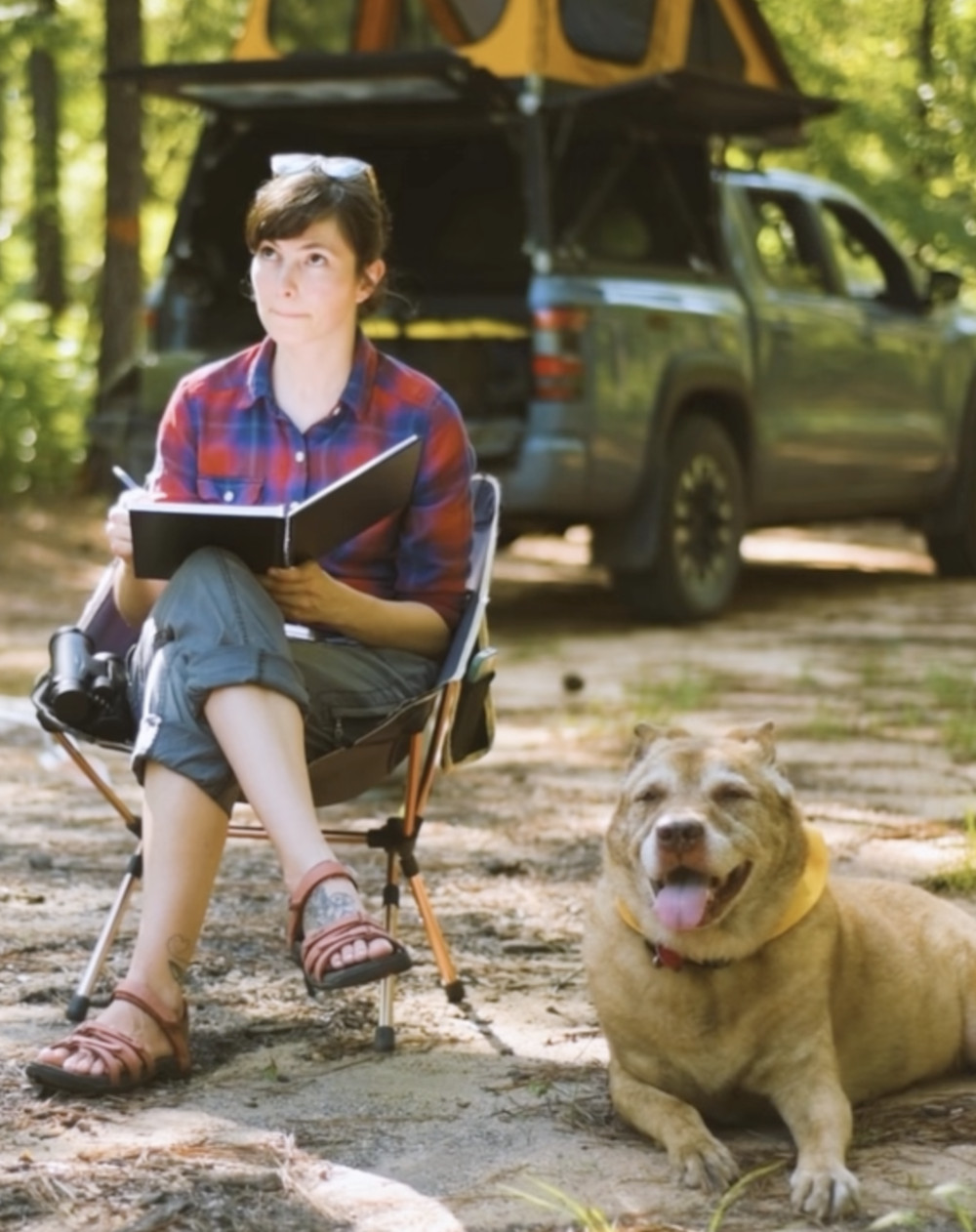
Tuco, the dog in the book, is my real life Tuco. He’s a senior now and we’re getting the van ready to accommodate an 80-pound senior dog. We’re excited. I think he’s going to love getting one more adventure in.
Previously in The Revelator:
Comics for Earth: Eight New Graphic Novels About Saving the Planet and Celebrating Wildlife

